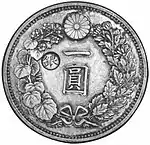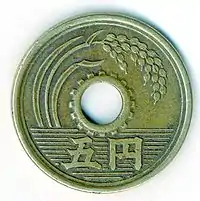Countermarked yen ("Gin")
Countermarked yen refers to Japanese trade dollars and 1 yen coins that are stamped 銀 ("Gin"), literally meaning "silver". The countermark was added by the Japanese government in 1897 to these coins dated up to that point. This came at a time when Japan went onto the gold standard prompting the government to confine these two denominations for use outside the mainland.

History
In 1871, a new coinage law was promulgated which helped with the final establishment of the gold standard system in Japan.[1] However, the process wound up stalled as the Mexican dollar at the time was the universal median of exchange. The Japanese government eventually came to the conclusion that the best interest of foreign trade was to issue silver one yen coins alongside standard gold coins. Silver one yen coins were first struck in 1871 for the mainland before being switched over for use outside of Japan in 1874.[1] Trade silver dollars (also referred to as "Boyeki ichi yen gin") were first struck in 1875 and were legal tender only within the limits of the trade treaty ports.[1] These trade dollars were only produced until 1877 before being discontinued in 1878. Japan had officially switched to a bimetallic standard which made one yen silver coins legal tender throughout the country.[2]
The Japanese government officially recalled and demonetized all silver one yen pieces and Trade Dollars in 1897. Trade dollars in particular were recalled as their silver content was now greater than the competing Mexican Dollar.[3] Many of these two types of coins were melted down to provide bullion for the production of subsidiary coins. Those that were not melted were either kept away by the public or sent overseas for trade. At least 20 million former Trade Dollars and 1 Yen coins were countermarked in 1897 with the character "Gin" for use in Japanese-occupied Taiwan, Korea, and Lüshunkou.[4][5] The mark was put in place by the Japanese mints at Osaka and Tokyo to identify these coins as simply bullion. Those that were stamped on the left originated from Osaka, while those on the right were from Tokyo. By placing this mark the Japanese government prevented these coins from being sold back to them at a later date for gold.[5] Silver one yen coins would not be stuck again until 1901, when they served as a reserve fund for "Bank of Formosa" notes.[6]
Collecting
Countermarked yen are not considered damaged as the marks were placed officially by a government entity. Marks that were placed in Tokyo on the right side of the coin are significantly rarer than those from Osaka.[7] The overall value of these coins may be marginally affected depending on individual collector preferences.[8]
See also
References
- Alfred Stead (1904). Japan by the Japanese. W. Heinemann. p. 326.
- Gold Standard in International Trade. U.S. Government Printing Office. 1905. p. 485.
- Richard S. Yeoman (1957). A Catalog of Modern World Coins. Whitman Publishing Company. p. 284.
- Krause, Chester L. and Mishler, Clifford: 1996 Standard Catalog of World Coins (Iola, WI: Krause Publications, ISBN 0-87341-357-1), p. 1370.
- Colin R. Bruce, Marian Moe (1995). Collecting world coins: a full century of circulating issues. Krause Publications. p. 1949.
- Cornell University (1903). Appletons' Annual Cyclopaedia and Register of Important Events. D. Appleton & Company. p. 354.
- "Collecting Japanese Silver Yen: The Dragon Yen 1870-1914". Antique Marks. Retrieved August 13, 2020.
- Star City Homer. "Japan Type Set #7460 Meiji, 1 yen, gin right, 1870-1896". NGC Collectors Society. Retrieved October 15, 2020.

